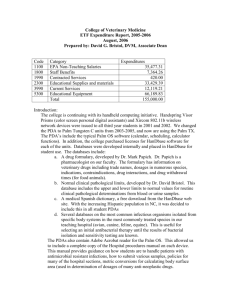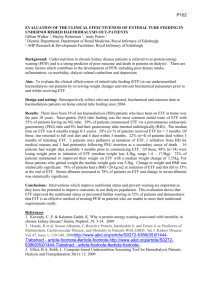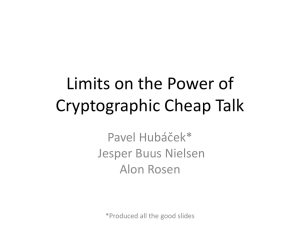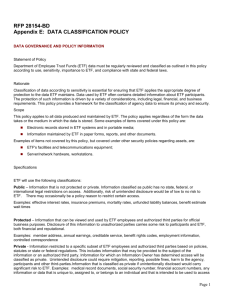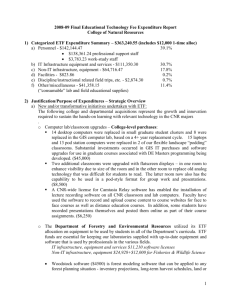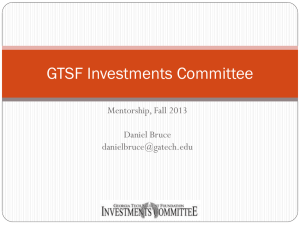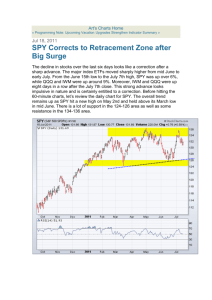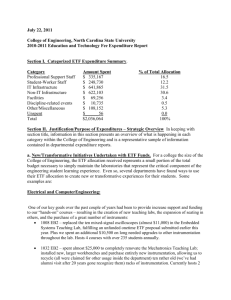2007-2008 Educational Technology Fee Expenditure Report
advertisement
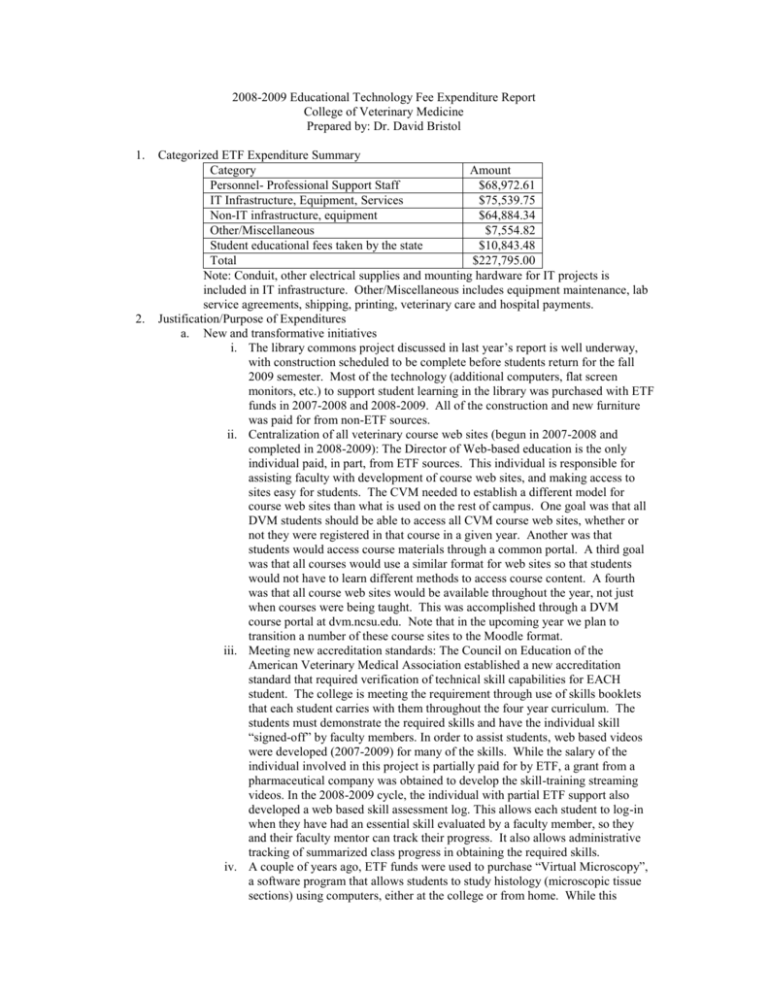
2008-2009 Educational Technology Fee Expenditure Report College of Veterinary Medicine Prepared by: Dr. David Bristol 1. 2. Categorized ETF Expenditure Summary Category Amount Personnel- Professional Support Staff $68,972.61 IT Infrastructure, Equipment, Services $75,539.75 Non-IT infrastructure, equipment $64,884.34 Other/Miscellaneous $7,554.82 Student educational fees taken by the state $10,843.48 Total $227,795.00 Note: Conduit, other electrical supplies and mounting hardware for IT projects is included in IT infrastructure. Other/Miscellaneous includes equipment maintenance, lab service agreements, shipping, printing, veterinary care and hospital payments. Justification/Purpose of Expenditures a. New and transformative initiatives i. The library commons project discussed in last year’s report is well underway, with construction scheduled to be complete before students return for the fall 2009 semester. Most of the technology (additional computers, flat screen monitors, etc.) to support student learning in the library was purchased with ETF funds in 2007-2008 and 2008-2009. All of the construction and new furniture was paid for from non-ETF sources. ii. Centralization of all veterinary course web sites (begun in 2007-2008 and completed in 2008-2009): The Director of Web-based education is the only individual paid, in part, from ETF sources. This individual is responsible for assisting faculty with development of course web sites, and making access to sites easy for students. The CVM needed to establish a different model for course web sites than what is used on the rest of campus. One goal was that all DVM students should be able to access all CVM course web sites, whether or not they were registered in that course in a given year. Another was that students would access course materials through a common portal. A third goal was that all courses would use a similar format for web sites so that students would not have to learn different methods to access course content. A fourth was that all course web sites would be available throughout the year, not just when courses were being taught. This was accomplished through a DVM course portal at dvm.ncsu.edu. Note that in the upcoming year we plan to transition a number of these course sites to the Moodle format. iii. Meeting new accreditation standards: The Council on Education of the American Veterinary Medical Association established a new accreditation standard that required verification of technical skill capabilities for EACH student. The college is meeting the requirement through use of skills booklets that each student carries with them throughout the four year curriculum. The students must demonstrate the required skills and have the individual skill “signed-off” by faculty members. In order to assist students, web based videos were developed (2007-2009) for many of the skills. While the salary of the individual involved in this project is partially paid for by ETF, a grant from a pharmaceutical company was obtained to develop the skill-training streaming videos. In the 2008-2009 cycle, the individual with partial ETF support also developed a web based skill assessment log. This allows each student to log-in when they have had an essential skill evaluated by a faculty member, so they and their faculty mentor can track their progress. It also allows administrative tracking of summarized class progress in obtaining the required skills. iv. A couple of years ago, ETF funds were used to purchase “Virtual Microscopy”, a software program that allows students to study histology (microscopic tissue sections) using computers, either at the college or from home. While this expenditure predates the expenditures for the current report, it is being included here because the faculty member overseeing the initiative, Dr. Jennifer Neel, has had a publication and several presentations resulting from that educational initiative. The most recent accepted presentation, for the 2009 American College of Veterinary Pathologists meeting follows: STUDENT USE OF VIRTUAL MICROSCOPY IN LEARNING CYTOPATHOLOGY, J.A. Neel, C.B. Grindem, Department of Health and Pathobiology, College of Veterinary Medicine, North Carolina State University, Raleigh, NC. This is an indication that the initiative was seen as “transformative” when reviewed by peers from other universities. b. Actions taken to improve efficiency i. ETF funds are insufficient to meet the many teaching needs, including projects such as the library commons sited above. Therefore they are commonly matched with funds from other sources. For instance, the library commons project is expected to cost approximately $700,000, of which less than $100,000 will be from ETF. (ETF is being used for the technology students will use in the new learning commons). ii. ETF is insufficient to meet the supply costs of the laboratories in the veterinary medical curriculum. These additional costs are met though other state funds and contract income. For instance, unlike human medical students, veterinary students must be competent surgeons the day they graduate. Surgical laboratories are expensive endeavors. In the past year, $51,678 of ETF support went to two surgical laboratory courses that are part of our core curriculum. However, these labs alone would not adequately prepare our students for the surgical procedures they will be expected to from when they graduate. Therefore, we have partnered with the Wake County Animal Care, Control and Adoption Center (WCACCAC). The college pays the salary of a faculty member and veterinary technician at the WCACCAC (non-ETF funds) and in return the WCACCAC has renovated facilities for a veterinary surgical unit. Our students perform the spays and neuters at the shelter. This provides the county with a service and our students with surgical experience. c. Unmet ETF needs i. ETF only meets a small percentage of course associated laboratory supply costs in the CVM. In 2008-2009, ETF was used for $51,677.87 of surgical laboratory costs. Over $154,600 was allocated from other sources for courses with significant laboratory components. In addition, many of our food animal clinical rotations require transporting students to farms for training. Those transport costs are built into the course budgets rather than being included in the Field Trip/Professional Development portion of the ETF budget. Stated another way, ETF covered a small percentage of eligible laboratory costs. ii. The CVM maintains an on-site farm, the Teaching Animal Unit, to aid with student instruction in farm species. Herds of horses, dairy cattle, beef cattle, sheep, goats, pigs and flocks of poultry are all managed in typical agricultural production methods. It is critical that our increasingly urban/suburban student population have access to these herds/flocks so they can be competent veterinary graduates. The recent rapid increase in fuel and feed prices have had led to a dramatic increase in costs of maintaining this facility. Feed prices have increased due to a number of factors including increase fuel prices to transport feed and decreased national production of animal feeds (hay, certain grains) in favor of producing corn for biofuel production). None of the laboratory costs associated with courses in the teaching animal unit are supported by ETF. 3. iii. Library Commons Project: Most of this project, which is meant to bring current information technology to the CVM library for student use, is being funded from non-ETF sources. d. Assessment: We do not conduct a separate assessment of effectiveness of ETF expenditures. These expenditures are often mixed with expenditures from other sources to accomplish college educational goals. The Library Learning Commons Project is a good example of this. Similarly, upgrades to laboratories (anatomy, multipurpose microscopy lab) are made using a variety of sources. For traditional laboratory supplies, we do not separately assess supplies purchased from ETF sources from those purchased with non-ETF funds. All courses, whether funded from ETF or non-ETF sources, are evaluated on a regular cycle. The individual whose salary is partially supported by ETF is reviewed annually as part of the normal employee evaluation process. e. Planning and review process: Distribution of ETF funds within the CVM is done by the Associate Dean and Director of Academic Affairs. The associate dean meets with class leaders (presidents and vice presidents of each class, plus the president and vice president of the student chapter of the AVMA) approximately 6 times per year to discuss a variety of student issues including use of ETF. Student feedback on special projects (one-time funds) are sought at these meetings. In addition, applications for “one-time” funding are discussed and prioritized with the Faculty Committee on Curriculum and Course Evaluation. This committee is composed of faculty from each department in the college and students from each class. Planning for the Library Learning Commons project involved a team of faculty, staff, and students from each veterinary class. Summarized list of expenditures: Category 511xx EPA Non-teaching Salaries 518xx Staff Benefits 519xx Contracted Services 52xxx Supplies and Materials 53xxx Current Services 54xxx Fixed Charges 55xxx Capital Outlays Student fees taken by the state Total CVM Amount 56,477.21 12,495.40 1,274.38 106,151.86 5,331.65 3,169.02 32,052.00 10,843.48 227,795.00 Note that a number of tablet computers were ordered for distribution to selected students to test our hospital and classroom systems in preparation for a college wide tablet computer initiative, scheduled for fall, 2010. Payment for these was refused by the state during the end of year budget freeze. Return of the items was refused by the vendor.
